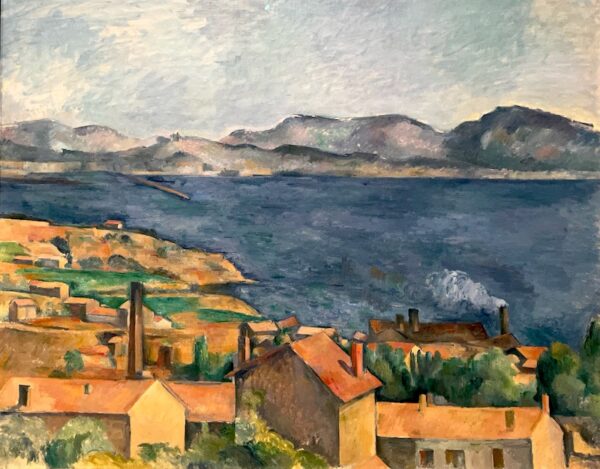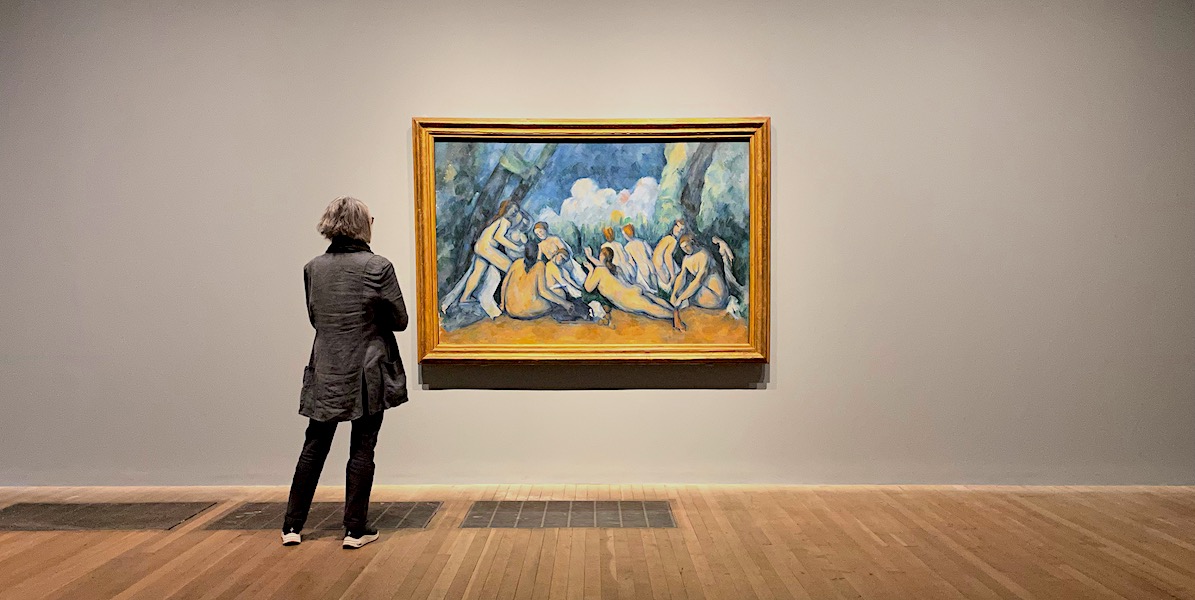The Tate Modern’s Paul Cezanne exhibition is probably one of the most elaborate and rich exhibitions this year. Spanning the entirety of Cezanne’s painting career, from beginning to end, audiences are treated to a multitude of rooms, each carefully curated to reflect a specific time period in the artist’s life and depicting his evolution as a painter trying to find his place in the socio-political and artistic landscape of the time. Cezanne is known as the father of Modernism and this exhibition goes a long way in substantiating this claim.
The Tate Modern exhibition provides us with an incredibly in-depth look into Paul Cezanne as an artist, family man, and human
It isn’t easy to sum up this extensive exhibition. Seeing such a large grouping of Cezanne’s works, it was almost difficult to pinpoint which works of art I and many others think of as distinctively Cezanne. Is it the still-life work, such as Still Life With Fruit Dish? Or maybe one of the many paintings depicting the Mont Sainte-Victoire? Or perhaps it’s The Bathers, notably one of the larger pieces in the exhibition, that we think of as quintessentially Cezanne.

In an interesting curatorial choice, the first room holds a painting titled The Basket of Apples and a self-portrait, perhaps suggesting his place in a certain artistic tradition, that of the self-assured male artist with a decisive style, which is subverted in the rest of the exhibition. Indeed, as we walk on through different eras of his art practice, we see that throughout the vast subject matter, encompassing portraits of family members, landscapes painted outdoors, carefully controlled studio-painted still-lives, and nude figures, it is clear the subject matter does not bind his work together. Nor does his artistic style, which seems to shift depending on the subject matter and setting of the painting. For instance, the distinctive parallel brushstrokes Cezanne uses in works such as Turn in the Road seem to take on a new life in Scipio.
There is a clear evolution in his use of colour and economy of paint as he drifts between subject matter, sometimes seeming to engage in politics, such as in The Murder, a small scene of violence between three characters, painted with a dark and stormy palette and thicker paint, which seems like the antithesis of a typically Cezanne work, if one exists.
Though a problematic painter to cinch, Cezanne notably gives the same weight to human subjects as he would to an apple or a tree in his other paintings. While containing a beautiful intimate quality, the portraits of his wife and son maintain an enigmatic aspect. It’s as though whilst studying them, Cezanne’s preoccupation was not with having their personality shine through but rather with capturing the weight of their presence. This is especially apparent in Madame Cezanne in a Yellow Chair, a portrait of his wife looking off into the distance, clasping her hands in her lap. The effect is a curious one. Madame Cezanne is at the same time remote and weightless, ungrounded by the flat picture plane behind her, while at the same time firmly present and corporeal, the darkly outlined red dress giving her most of her presence.

Another portrait, which was a standout piece in the exhibition, is perhaps a further attempt at socio-political commentary on Paul Cezanne’s part. Alongside The Murder, this painting is far removed from anything that typifies a Cezanne work, yet because of that, stands out with even more clarity. Set apart from the other portraits in the room of Cezanne’s family, Scipio depicts a young black man sitting on a stool, his back turned to us. Although his posture and peaceful expression connote a restful state, the taught muscles of his right arm, gripping the stool’s edge, hint at something else. Thought to be a comment on the abolitionism of the time, the muted grey background, loose brushstrokes, distinct colour planes and composition make this an arresting painting. Compared to the other portraits presented here, this one has a distinctly human warmth to it.
The groupings of the L’Estaque paintings, where Paul Cezanne is said to have defined his artistic style, are mesmerizing. The blue and terracotta hues draw us in, and one can almost hear the sound of the trees in L’Estaque with Red Roofs. A non-negligible step in his artistic career, his time in L’Estaque clearly impacted the rest of his artwork for the remainder of his life and is given appropriate space here.
The wonderful The Bathers is a piece that needs no introduction yet endures time and time again. Having wandered through a thorough summary of Cezanne’s work, The Bathers seems to take all the successful elements of previous paintings, culminating in something which, in my opinion, could not be more “Cezanne” if he tried. The mystical quality of the cubist figures gives this painting the same aura as the breezy L’Estaque pieces while also being grounded by the grouping of figures, as in any of his still-lifes. The feeling of quiet and stillness of the figures, combined with the floaty landscape, juxtaposes the star elements of Cezanne’s artistic style. Combining his experiments with outdoor painting, multiple figures, and still life, it really is everything you could want in a Cezanne work and more.
Overall, the Tate Modern exhibition provides us with an incredibly in-depth look into Cezanne as an artist, family man, and human trying to find his place in a shifting political landscape while also trying to find his artistic voice. Each room flows into the next, and even the outliers are swept up and given their time in the spotlight in this fantastic exhibition. It is well worth seeing and spending time on, perhaps taking a moment to sit in the dimly lit final room to take it all in before leaving Cezanne’s world.
Words by Leila Lebreton, Photos ©Artlyst 2022
Cezanne: The EY Exhibition, Tate Modern, 5 October 2022 – 12 March 2023

